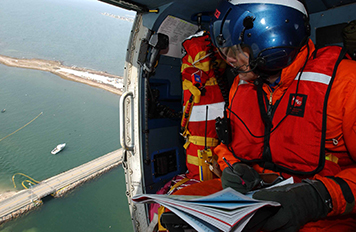Response Tools for Oil Spills
Here is a quick guide to many of the most commonly used tools and resources that NOAA OR&R offers for oil spill responders and planners. General emergency responders may also want to refer to the quick list of tools and resources for chemical spill response.

NOAA develops a number of emergency response and planning tools for dealing with oil and chemical spills.
Software and Datasets
- GNOME suite and related programs:
- WebGNOME, NOAA's publicly available Web-based trajectory model that provides a user-friendly interface for modeling oil spill scenarios.
- PyGNOME, a scripting interface for automation and batch processing.
- GOODS, a tool that helps GNOME users access base maps, ocean currents, and winds.
- Desktop GNOME, the legacy version of GNOME; predicts the possible route pollutants might follow on the water's surface.
- Desktop ADIOS®, an oil weathering model.
- Trajectory Analysis Planner (TAP), oil spill contingency planning software.
- NUCOS, a unit converter that includes units unique to oil spill response.
- ERMA®, the online mapping tool for environmental response data, adapted to a variety of regions.
- Environmental Sensitivity Index (ESI) maps and data, concise summaries of coastal resources that may be at risk in a spill incident.
- Web CAFE, and the desktop CAFE Database, programs to help responders in their assessment of environmental impacts from oil or chemical spills into an aquatic environment.
- Response System Planning Tools, tools to assess system performance of oil spill response methods, including mechanical recovery of oil, dispersant application, and in situ burning of oil.
- DIVER (Data Integration, Visualization, Exploration, and Reporting) tool, an application developed by NOAA to support the natural resource damage assessment process.
Publications, Training, and Other Resources
- FOSC's Guide, describes the scientific products and services that NOAA can provide to FOSCs (Federal On-Scene Coordinators).
- Incident Command System (ICS) forms, available as an electronic database.
- Job Aids, field guides to assist with various response tasks.
- Publications, a list of our spill response reports, guides, and publications.
- Seafood Safety After an Oil Spill, background information and publications describing how to monitor seafood for exposure and contamination after an oil spill.
- Training, classes and self-study options for spill response professionals.
More Information about Oil Spill Response
Learn more about OR&R's tools and resources for oil spill response. You can also find contact information for SSCs around the U.S., and a sampling of research publications written by OR&R scientists and other partners.
Last updated
Friday, December 15, 2023 9:12pm PST
